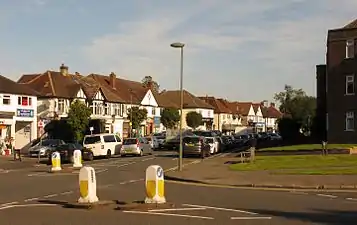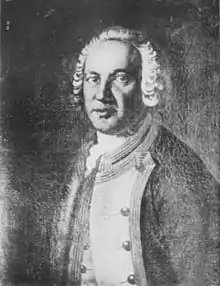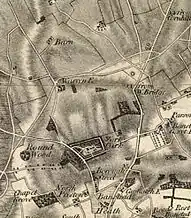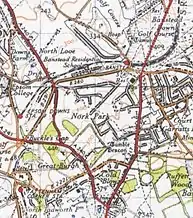| Nork | |
|---|---|
 Nork ward in 2011, outlined in black[1] | |
 Nork Location within Surrey | |
| Area | 3.63 km2 (1.40 sq mi) |
| Population | 7,559 (2011 Census)[2] |
| • Density | 2,082/km2 (5,390/sq mi) |
| OS grid reference | TQ241598 |
| District | |
| Shire county | |
| Region | |
| Country | England |
| Sovereign state | United Kingdom |
| Post town | Banstead |
| Postcode district | SM7 |
| Post town | Epsom |
| Postcode district | KT17 |
| Dialling code | 01737 |
| Police | Surrey |
| Fire | Surrey |
| Ambulance | South East Coast |
| UK Parliament | |
Nork is a residential area of the borough of Reigate and Banstead in Surrey and borders Greater London, England. Nork is separated from its post town Banstead only by the A217 dual carriageway, and the built-up area is also contiguous with similar parts of Tattenham Corner and Burgh Heath. A thin belt of more open land separates it from the communities to the north: Epsom, Ewell, Cheam and Belmont. There are two parades of shops, one called the Driftbridge and another at the north-eastern end of Nork Way, the street which runs centrally through the residential area. Nork lies on chalk near the top of the gentle north-facing slope of the North Downs, 175 m (575 ft) above sea level at its highest point.
History
It has been suggested that the word "Nork", as well as "Nore" and "Nower", might derive from the Latin noverca, which literally means a stepmother, but which was applied to a feature which dominates, and thus weakens, a fortified camp.[3] Others consider it more likely to be derived from the Old English word "nook", meaning secluded, tranquil and a corner.[4] A third proposed derivation is from "northern oak".[5]
The first recorded application of the name was to a "Nork close" (enclosed field) in 1723.[6] It was then applied to Nork House, built in 1740 by Christopher Buckle (1684–1759).[7][8] The Buckle family were owners of the adjacent Burgh Manor from 1614 to 1847.[9] In the 18th and 19th centuries Nork could be considered an agricultural hamlet of Banstead village, covering the fields and buildings in the extensive grounds of Nork Park (surrounding Nork House). The line of trees planted to mark the park's northern boundary has given its name to Fir Tree Road.[7] John Burton, author of Iter Surriense et Sussexiense, stayed at Nork House in 1752, and described at length the ingenious waterworks by which water was raised from a very deep well and distributed over the slopes of a dry down.[9]
In 1834 a celebrated highway robbery and murder occurred along what is now Yew Tree Bottom road where it joins the Reigate Road (Purcell's Gap). A Mr Richardson, returning from the Epsom cornmarket to Bletchingley, had dismounted on account of the steep climb, and was ambushed by two men whom he had considered suspicious on his outward trip that morning.[10][11] Later in that century the railway arrived (1865), primarily to serve Epsom Racecourse.[12] Then in 1880 a large "cottage home" for children opened along the northern edge of Nork, between Fir Tree Road and the railway line. It was originally called "The Kensington and Chelsea District School" and later "Beechholme". At its peak, over 400 children were accommodated. The school closed in 1974 and the area was rebuilt with modern housing.[13][14]
In the 19th century, the Buckle family had sold their estates to the Perceval/Arden family, who in turn sold them to the Colman family, of mustard fame.[15] In 1923, the Nork estate was sold to a development company and Nork House itself was demolished in 1939.[16] Housing development became rapid after 1923, and in 1925 the Nork Residents' Association was formed, publishing the Nork Quarterly, a bulletin that still appears regularly today.[15][17][18] Nork began to be used as an official place name outside of the park itself from 1965 when Banstead was divided into two wards named "Banstead Village" and "Nork", equal in population and number of councillors.
During World War II, Nork received occasional damage from bombs, V-1 flying bombs and crashed aircraft. Some fortifications were built in preparation for an invasion, and later Canadian and British soldiers were stationed in Nork Park, occupying some of the buildings remaining from the estate as well as specially constructed Nissen huts.[19][20][21][22] After the war, the Nissen huts were utilised by the council as temporary accommodation for council tenants, then demolished as tenants were moved into prefabs.[23]
Housing development continued after a break during the war. Amongst the last large-scale developments were the Rose Bushes estate in the 1960s and the High Beeches estate in the 1970s.[14][24] Recently, in-fill development has converted some of the large rear gardens of the original development into small housing schemes; there is opposition to this from some local residents and their elected representatives.[25]

Monuments and buildings of note
In a front garden along The Drive lies Tumble Beacon, a scheduled ancient monument. Originally it was a prehistoric bowl barrow, a funeral monument situated, as is typical, on one of the highest prominences in the region. At latest in Tudor times, it was built up to serve as a beacon where a fire would be lit to warn of the approach of hostile forces. In World War II an air-raid shelter was dug inside.[26][27]
A group of Saxon burial mounds, or hlaews, lies in the north part of Nork ward on the part of Banstead Downs west of the main A217 road. When one was excavated in 1972, archaeologists found late 7th, or possibly early 8th, century artefacts, including a spear, knife, shield boss, hanging bowl and textile. The primary burial was of a well built and unusually tall (1.9 m; 6 ft) warrior, a regular horse rider, probably in his late 20s. Another five skeletons appeared to be centuries-later victims of the medieval gallows that gave rise to the local place name Gally Hills.[28][29][30]
In 1912 the Colman family rebuilt the mansion called Great Burgh, over the Reigate Road from Nork House. This neo-Georgian house is now a Grade II listed building.[31] It was used as a research establishment by the Distillers Company (during which time a number of important chemical processes were developed there),[32] then by British Petroleum and Beecham Pharmaceuticals, and later as offices and accommodation by Toyota, who have their UK headquarters here.[33][34] Since 2016, the original building has been occupied by the Science Group and their subsidiary Leatherhead Food Research.[34] The house's architect Ernest Newton also designed the formal gardens and parterres.[31][35]
Amongst "locally listed buildings" are two estate cottages (Driftways and Crossways) near the Driftbridge, both built about 1890,[36] and West Lodge, a flint-built gatehouse for Nork House on the Reigate Road.[37] A pair of 19th-century stone gate piers standing incongruously at the south end of Ruden Way are also from an entrance to the Nork Park estate.[37] The former Drift Bridge Hotel (see next section) is locally listed partly because the teak used in its 1931 construction came from HMS Ganges, the Royal Navy's last sail-powered flagship.[37]
Amenities
The buildings in the area are predominantly detached or semi-detached houses.[2] There is much inconsistency in style in the original developments of the inter-war years because different builders had purchased single plots.[15] Such properties often have unusually large gardens (planning authorities sometimes limited density to 6 houses per acre).[15] The streets typically have a grass verge with trees between road and pavement.
The shopping parade at the end of Nork Way consists of small convenience stores and local services such as newsagents (including a post office), restaurants, motor mechanics, a baker's and a pharmacy.
In the west part of Nork is another small shopping parade, known as The Driftbridge, named after the former Drift Bridge Hotel and adjacent garage at the crossroads of Fir Tree Road and the Reigate Road (A240). The hotel later became a Toby Inn[38] and in 2007 was converted into apartments. There are now no hotels or pubs in Nork, the closest ones lying at the far end of Banstead village and at Tattenham Corner.[39]
A smaller, third parade of shops lies just south of Nork ward, on Tattenham Way.
 Nork Way
Nork Way Nork shops
Nork shops Parade at Driftbridge
Parade at Driftbridge Church of St Paul
Church of St Paul Interior of St Paul's
Interior of St Paul's
The Anglican church of St Paul in Warren Road was opened in 1930 specifically to serve the new housing estates in Nork.[4] The Roman Catholic and Methodist churches for Banstead are also situated in the Nork ward: for more details see the list of places of worship in Reigate and Banstead.
These three churches each have a church hall. Other venues for local events and indoor sports are the community centre in Nork Park off Nork Way and Scout Ridge near Banstead Station.

Transport
Banstead railway station lies near the shops at the north end of Nork Way. It is on the single-track Epsom Downs branch line between Epsom Downs station (also officially in the Nork ward) and the main-line junction at Sutton, from where trains continue to London. When the line was opened in 1865 the end station at Epsom Downs had 9 platforms to cope with visitors to the racecourse, but in 1989 the station was resited and rebuilt with just one platform.[12] Also within easy walking distance of parts of Nork is Tattenham Corner station, the end station of the Tattenham Corner Line from the mainline junction at Purley.
Nork is also served by several bus routes, some running through Nork itself (166, 318), and others accessible from nearby Tattenham Way (420), Banstead High Street (S1) or Tattenham Corner (460/480). Direct destinations include Epsom, Croydon, Sutton, Mitcham, Redhill, Gatwick Airport and Crawley.[40]
Schools
Warren Mead Infant School and Warren Mead Junior School are in Nork.[41] The Beacon School is an academy secondary school located next to Nork Park, and was formerly known as Nork Park School. Confusingly, The Beacon School had been the name of a preparatory school on the site where Beacon Close now stands.[42] Residents are also likely to send their children further afield for education.

Nork Park
Nork Park lies to the south of the main residential area, bordering Tattenham Corner and Burgh Heath. It derives from part of the 18th century park around the demolished Nork House,[35] and was bought by the local council in 1947 from the landowner David Field.[16] Subsequently, parts of the area have been used for grazing horses, cattle and goats, but now the entire area is accessible to the public.[43] The Park is partly chalk grassland of value for its flora, and there are also hedgerows, avenues and areas of woodland, including a small arboretum. It is much used for dog walking.[23] There are extensive areas of playing fields, tennis and basketball courts, an exercise trail, two children's playgrounds, and a community centre. Several car parks provide access and adjacent parking is also possible along Nork Way. The local community organises a popular open-air music festival called "Music in the Park" that runs one afternoon in summer; 2022 marked the 30th such event.[44][45]
Banstead Downs


About a third of Banstead Downs lies in the north of Nork ward, where it is occupied by a golf course. Banstead Downs has been designated a Site of Special Scientific Interest. The golf course provides a mixture of types of grassland with a rich chalk flora (including a number of locally rare plants) and areas of mixed scrub important for birds. (Over the whole of these downs 57 species of bird have been recorded, of which 44 have bred.) In addition there is some more mature oak and hawthorn woodland. The invertebrate fauna includes very rare and localised species.[46][47]
Banstead Downs has been preserved as a result of a 16-year long legal battle at the end of the 19th century between the Commoners and Sir John Cradock-Hartopp, who wished to exploit the land for housing and topsoil. As a result, after 1893 the Downs has been administered by the Banstead Commons Conservators.[48]
Near the 18th tee of the golf course is a memorial to an American pilot Lt Andrew Jackson, who bravely steered his plane away from houses, crashing here in 1944.[49] Elsewhere on this golf course lies the Gally Hills ancient monument, described above.
The London Loop, a 240 km signed walk around London, passes through Nork here, crossing the Brighton Road (A217) just north of Banstead Crossroads.[50] The walk is divided into sections designed to start and end at points accessible by public transport and Banstead Station forms one such "official" point of access.
Demography
The 2011 census recorded the population as 7556 (cf. 7351 in 2001); 22% were under 18 and 19% over 65. The area is fairly prosperous and middle-class: of those residents aged 16–64, 38% had university or professional qualifications (England and Wales = 30%) and 79% were in employment (England and Wales = 71%). In 2018, only 0.5% of this age group were claiming out-of-work benefits (cf. 2.3% for Great Britain). In 2011, only 6% of households lacked a car and 60% had more than one. The population was 92% white with 90% of residents born in the UK. [51][1] [52]
Political representation
As of 2022, all three Reigate & Banstead borough councillors for Nork Ward represent Nork Residents' Association.[53] The Surrey County Councillor for the Nork and Tattenhams Ward is Nick Harrison (Nork and Tattenhams Residents' Association).[54] The Member of Parliament for the Epsom and Ewell constituency (of which all of Nork forms a part[55]) is Christopher Grayling (Conservative).[56]

Notable residents
- Admiral Matthew Buckle (1718–1784)[57]
- George James Perceval, 6th Earl of Egmont (1794–1874), admiral, Member of Parliament[58][59]
- Frederick Edward Colman DL (1841–1900), managing director of Colman's the mustard manufacturers, bought Nork House in 1890 and lived there until his death; his family remained until 1923.[60][61]
- The author and radio producer Simon Brett (1945–) grew up in Nork.[62]
- The comedian David Walliams (1971–) grew up in Nork and was a lifeguard at Banstead Sports Centre.[63]
References
- 1 2 Nomis. "2011 Ward Labour Market Profile E36005746 : Nork". Office for National Statistics. Retrieved 5 March 2015.
- 1 2 "UK census data: Nork". UKCensusdata.com. Retrieved 5 March 2015.
- ↑ Urban, S. [pseudonym of E. Cave] (1843). "The novercae of Roman camps". Gentleman's Magazine, and Historical Chronicle. 55: 140–141.
- 1 2 Anonymous. "A brief history of St Paul's church, Nork". Church of England. Archived from the original on 2 April 2015. Retrieved 5 March 2015.
- ↑ Anonymous. "Roads". Banstead History Research Group. Retrieved 19 March 2015.
- 1 2 3 Lambert, H.C.M. (1912). History of Banstead. London: Oxford University Press. OL 23304266M.
- 1 2 Banstead History Research Group (2005). The history of Banstead Vol. I: the "olden days". From the Romans to Queen Victoria. Banstead History Research Group. ISBN 0951274171.
- ↑ Sweetman, J. "The Buckle Family". Banstead History Research Group. Retrieved 29 September 2015.
- 1 2 H.E. Malden, ed. (1911). "Parishes: Banstead". A History of the County of Surrey: Volume 3. Institute of Historical Research. Retrieved 28 September 2013.
- ↑ Anonymous. "Horrid murder and highway robbery". Epsom and Ewell History Explorer. Retrieved 19 October 2015.
- ↑ Van der Kiste, John (2009). Surrey Murders. Stroud: The History Press. ISBN 978-0750951302.
- 1 2 Wymann, A. "The Epsom Downs Branch Website". Retrieved 18 March 2015.
- ↑ Maciejewski, R. (2010). Beecholme: a children's village. Banstead History Research Group. ISBN 978-0-9550768-4-8.
- 1 2 Higginbotham, Peter. "Kensington & Chelsea School District: Banstead Cottage Homes". The workhouse: the story of an institution. Retrieved 15 October 2015.
- 1 2 3 4 Banstead History Research Group (2005). The history of Banstead Vol. II: how a village grew and changed. Banstead History Research Group. ISBN 0951274198.
- 1 2 Old Surrey Downs Project. "Town and Down Circular Walk" (PDF). Reigate and Banstead Borough Council. Archived from the original (PDF) on 13 May 2013. Retrieved 5 March 2015.
- ↑ "The Residents' Association: how it all began". Nork Residents' Association. Retrieved 4 March 2015.
- ↑ "Nork Quarterly". Nork Residents' Association. Retrieved 20 January 2019.
- ↑ Robinson, Geoffrey. "Me and the war in Banstead (part one)". BBC, Banstead History Centre. Retrieved 19 March 2015.
- ↑ Robinson, Geoffrey. "Me and the war in Banstead (part two)". BBC, Banstead History Centre. Retrieved 19 March 2015.
- ↑ Robinson, Geoffrey. "Me and the war in Banstead (part three)". BBC, Banstead History Centre. Retrieved 16 October 2015.
- ↑ Skinner, D., Smith, J., Wilman, R., Christie, L., Forth, J., Slaughter, T., Woodman, M. "Banstead wartime memories". Banstead History Research Group.
{{cite web}}: CS1 maint: multiple names: authors list (link) - 1 2 Anonymous. "Nork Park". Reigate and Banstead Borough Council. Retrieved 17 October 2015.
- ↑ Anonymous. "Property history of 22 Rose Bushes, Epsom KT17 3NX, 18th Aug 2014". Zoopla. Retrieved 15 October 2015.
- ↑ Anonymous (27 June 2013). "Shock at proposal for "intensification" of homes in Nork and Tattenhams". Surrey Mirror. Archived from the original on 2 April 2015. Retrieved 13 March 2015.
- ↑ Historic England. "Bowl barrow and later beacon at Tumble Beacon (1009804)". National Heritage List for England. Retrieved 5 March 2015.
- ↑ Renn, Derek (29 April 2004). "Untitled". Leatherhead Advertiser. Retrieved 5 March 2015.
- 1 2 Historic England. "Two Saxon burial mounds on Gally Hills, west of Brighton Road (1008054)". National Heritage List for England. Retrieved 5 March 2015.
- ↑ Barfoot, J.F.; Price Williams, D. (1976). "The Saxon barrow at Gally Hills, Banstead Down, Surrey". Surrey Archaeological Society Research Volumes. 3: 59–76.
- ↑ Reynolds, A. (2009). Anglo-Saxon Deviant Burial Customs. Oxford University Press. pp. 137–138. ISBN 9780191567650.
- 1 2 Historic England. "Great Burgh (including attached wall, railings, piers, terrace and steps) (1029020)". National Heritage List for England. Retrieved 5 March 2015.
- ↑ Bailey, H.C. (December 1988). "Herbert Muggleton Stanley, 20 July 1903 - 4 July 1987". Biographical Memoirs of Fellows of the Royal Society. 34: 787–813. doi:10.1098/rsbm.1988.0025.
- ↑ Savills Marketing. "Great Burgh, Epsom" (PDF). Savills. Retrieved 5 March 2015.
- 1 2 Foster, Alice (13 November 2015). "Leatherhead Research in £9M move to near Epsom". FoodManufacture.co.uk. Retrieved 14 April 2016.
- 1 2 McInally, John (2001). The list of historic parks & gardens: supplementary planning guidance. Reigate and Banstead Borough Council, Department of Policy and Environment. Retrieved 10 October 2015.
- ↑ McInally, John (2012). Locally listed buildings: results of consultations and proposed designation of additions to the local list (PDF). Reigate & Banstead Borough Council. Retrieved 21 April 2022.
- 1 2 3 Buildings & development services information (2014). List of buildings of architectural and historic interest (6th ed.). Reigate and Banstead Borough Council. Retrieved 11 October 2015.
- ↑ East & Mid Surrey branch of Campaign for Real Ale. "Driftbridge". East Surrey pub guide. Retrieved 5 March 2015.
- ↑ Anonymous. "Nork Community Association". Nork Residents' Association. Retrieved 3 October 2015.
- ↑ Anonymous. "Banstead, Epsom, Dorking and Leatherhead bus timetables". Surrey County Council. Retrieved 7 March 2019.
- ↑ "Schools by location". Surrey County Council. Retrieved 5 March 2015.
- ↑ Lee, Heather. "Memories of Beacon Preparatory School". Banstead History Group. Retrieved 13 August 2016.
- ↑ Foster, Alice (7 April 2014). "Cows brought in to create 'pastoral ambience' in Nork Park". Your Local Guardian. Retrieved 28 September 2016.
- ↑ Madden, C. (25 July 2014). "Photos: Nork is alive with the sound of music". Surrey Mirror. Archived from the original on 2 April 2015. Retrieved 13 March 2015.
- ↑ Snuggs, Tim (2022). "Music in Nork Park's 30th anniversary". Nork Quarterly. No. 73(2). Nork Residents' Association. p. 19. Retrieved 17 May 2023.
- ↑ Anonymous. "County: Surrey Site name: Banstead Downs" (PDF). Natural England. Retrieved 15 October 2015.
- ↑ Anonymous. "Banstead Downs". Banstead Commons and Banstead Commons Conservators. Retrieved 15 October 2015.
- ↑ Anonymous. "A brief history of the commons and conservators". Banstead Commons and Banstead Commons Conservators. Retrieved 15 October 2015.
- ↑ Anonymous. "Andrew Leslie Jackson: killed May 31, 1944". 33rd Photographic Reconnaissance Squadron Online. Retrieved 15 October 2015.
- ↑ "London Loop". Transport for London. Retrieved 15 October 2015.
- ↑ "Census 2011 ward profiles". Reigate and Banstead Borough Council. Retrieved 20 January 2019.
- ↑ "Census 2001 data". Reigate and Banstead Borough Council. Retrieved 20 January 2019.
- ↑ Anonymous. "Your councillors by ward". Reigate & Banstead Borough Council. Retrieved 3 January 2022.
- ↑ Anonymous. "Electoral divisions map". Surrey County Council. Retrieved 3 January 2022.
- ↑ Anonymous. "Epsom Constituency" (PDF). Epsom & Ewell Borough Council. Retrieved 3 January 2022.
- ↑ Anonymous (12 December 2019). "Election results for Epsom and Ewell: parliamentary election - Thursday, 12th December, 2019". Epsom & Ewell Borough Council. Retrieved 3 January 2020.
- ↑ Sweetman, J. "Matthew Buckle – Banstead's Naval hero". Banstead History Research Group. Retrieved 22 February 2015.
- ↑ Bouchard, Brian. "George James Perceval (1794–1874)". Epsom & Ewell History Explorer. Retrieved 5 March 2015.
- ↑ Smith, P. (Ed.) (2011). The Banstead boy at Trafalgar: George Perceval's letters to his parents Lord and Lady Arden 1805 to 1815. Banstead History Research Group. p. 55. ISBN 978-0-9566313-1-2.
- ↑ Howard, J.J.; Crisp, F.A. (1901). Visitation of England and Wales, Volume 9. Privately printed. p. 5. Retrieved 10 February 2018.
- ↑ LNW. "Group photo Nork House". Banstead Photo Archive. Retrieved 10 February 2018.
- ↑ Brett, S. "Simon Brett—Biography". Retrieved 28 June 2015.
- ↑ Walliams, David (2012). Camp David. Penguin. ISBN 9780141973241. Retrieved 10 February 2018.
External links
- Reigate and Banstead Borough Council
- Nork Residents' Association
- Zoomable boundary map and official labour market statistics
- Early pictures of Nork, particularly valuable for those of Nork House
- Francis Frith: photos, old OS map and anecdotes of Nork
- Francis Frith: photos and old OS map of Drift Bridge
- Oblique aerial photograph from 1921 showing Nork (in the background) before the housing development


